Modern cartridges for pistols and submachine guns
In addition, at the moment I have very little experience and knowledge to create voluminous material of this kind, so that such an article is not expected. Instead, I propose to talk about what ammunition, or rather what characteristics of ammunition, is currently especially important in different niches of use, well, to get acquainted with those cartridges that are most suitable for these criteria.
In no case do I pretend to the only true opinion, this article describes only my opinion, and not the ultimate truth, so disputes, reasoned criticism is welcome.
Cartridges for pistols and submachine guns, at the moment, one of the most popular topics for disputes. Despite the abundance of a wide variety of ammunition, the armies of many countries still use 9x19, and they are not in a hurry to retire on this ammunition in law enforcement. The 9х19 cartridge was and is the best option in terms of balance among many characteristics, but it is increasingly possible to find the opinion that this cartridge is already outdated and its further modernization is meaningless.
If the first statement, especially when using ammunition for army needs, can be agreed, then the second statement is more than debatable. It is possible and necessary to upgrade, but it is also necessary to take into account the weapon in which the new ammunition will be used, since not all designs will be able to "digest" the new cartridge normally, which means that it will also be necessary to modernize the weapon or develop new models for more advanced ammunition.
In other words, to squeeze the maximum out of the old cartridge will not work, without looking at the weapon, which, in most cases, hinders further development.
An important factor that influences the development of cartridges for pistols and PP is actually mutually exclusive requirements that are imposed on ammunition in the army and the police (we still do not take into account the civilian market).
For the army, the ammunition should have, first of all, high armor-piercing properties, no one refuses the so-called stopping action, but what's the point if the bullet cannot penetrate the body armor and the only effect from hitting the body of the enemy without penetrating wounds?
Nobody argues with the fact that the armored action when hit is unpleasant and can often cause serious injuries incompatible with life, but for such an effect a bullet with high kinetic energy is needed, which in turn will make weapons for such ammunition far from the easiest and most pleasant in application.
For law enforcement agencies, in the absolute majority of cases, on the contrary, ammunition with low armor-piercing properties is required, since police targets are very rarely protected by body armor, with the lowest possible propensity to ricochet upon contact with solid obstacles and the maximum possible stopping effect.
Thus, the army and the police need two completely different cartridges for their qualities, and two different cartridges are also two different versions of weapons for the army and the police. This, of course, is not a problem when there is money, but they usually even if there is, they want to keep it, and then they start looking for a compromise, the result of which is often very far from ideal.
Cartridges for pistols and submachine guns for the army
As already mentioned above, for an army pistol you need a cartridge with a bullet, which possesses, first of all, high armor-piercing properties, since, for the most part, the potential enemy will be protected by body armor. In this case, the weapon should be light and comfortable when worn, since it is not the main one, respectively, and the ammunition should be light and compact.
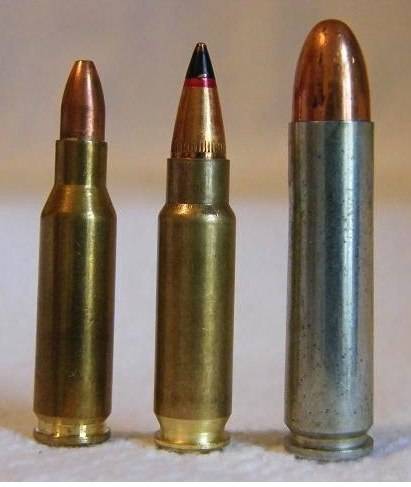
Significant contributions to the development of such weapons and ammunition were made by arms companies that were interested in the concept of personal weapons protection for military personnel. True, it should be noted that in the framework of this program, many turned a little out of place there and, in fact, developed submachine guns, which are clearly less convenient for everyday carrying, especially with the main weapon. Such PPs were offered as weapons for those who do not need a full-fledged machine gun, in most cases, that is, drivers, doctors, pilots, and so on, while the rest of the servicemen remained “in flight”.
You can argue for a long time whether you need a gun in the modern army at all. You can often find the statement that the gun is needed only to shoot, and as an element of dress form. However, due to its compact size, this weapon is indispensable in certain circumstances. And even when the machine fails or the ammunition runs out, a pistol with effective cartridges can help take more attackers with you, “get hold” of the enemy’s weapons, and there may not be a chance to shoot, with a fair amount of luck. In general, it is too early to write off such a class of weapon.
The concept of "Personal defense weapon" was developed more than a dozen of the most interesting ammunition. In the process of development, the designers, first of all, paid attention to the armor-piercing qualities, but many did not forget about the effectiveness of the hit, trying to implement it with various success.
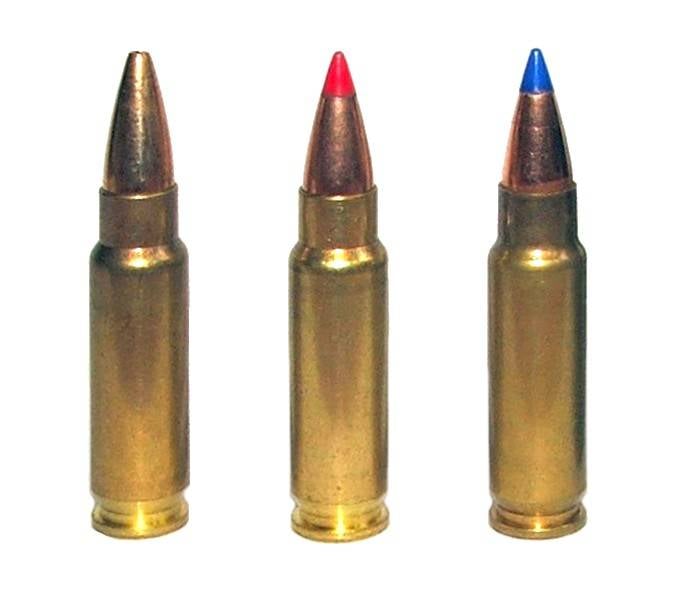
It is easy to see that almost all such ammunition, which is offered by foreign gunsmiths, have a small caliber, this is due not only to a decrease in the contact area of the bullet with a target when hit, but also one more important factor. As is known, the kinetic energy consists of two components, namely, the product of mass and square of velocity divided by two; we ignore the rotation of the bullet.
Thus, in order to increase the kinetic energy of a bullet, it is possible to increase its mass, but it is much more efficient to increase the speed, while sacrificing the mass of a bullet.
You can give a simple example. Suppose that the mass of a bullet is equal to 5 grams, and its speed is equal to 300 meters per second. Given such parameters, we obtain the kinetic energy of the bullet equal to 225 Joules. If you double the mass of the bullet, to 10 grams, the kinetic energy will increase to 450 Joule. In order to get the same kinetic energy from a five-gram bullet, the speed needs to be increased only by 125 meters per second. Of course, the first and second options, in the context of firearms, have their own nuances, but about them just below.
If back on the fingers to explain how the kinetic energy has to armor-piercing, then you can give an example with a hammer and a nail. If you put a nail on a wooden bar and put a hammer on it, say, weight in 450 grams, then nothing will happen. If you put a blank weighing 450 a kilogram on the same nail, the nail will enter the wood under the weight of this blank. However, if you take a hammer weighing 450 grams and hit the nail, the effect will be the same, and only the speed of the movement of the hammer will determine the nail in the bar by a third, half or completely under the cap. Here you can also include an example with a nail with a blunt and sharp tip, an attempt to break through a sheet of tin with an ordinary nail and hardened, in general, a nail and a hammer are irreplaceable items in the household. But from carpentry back to firearms.
To achieve the effect of armor-piercing, a bullet must have high kinetic energy, due to its high speed, small caliber and be strong enough not to collapse when it hits a solid surface of an armor plate. However, there is another factor that is one of the most important for bullets - stability in flight.
To give stability to the bullet, that is, so that it does not tumble in the air after the shot and fly at least in the direction the shooter was aiming, it is given a rotational motion about its axis, which is why the grooves in the barrel actually exist. Depending on the speed with which the bullet will move, the pitch of the rifling will be different, but it’s impossible to completely abandon them.

Work on high-speed ammunition has been going on for a very long time. The advantages of such cartridges are primarily in a flat flight path, as well as simplified firing at moving targets, with minimal lead. Of course, the armor-piercing qualities of such cartridges are not in last place.
Just the same in the process of working on such ammunition, the designers faced the problem of stabilizing the bullet in flight, namely with the disruption of the bullet from the rifling at high speeds. That is, instead of starting the rotational movement in the barrel due to the passage through the cuts, some part of it was cut off from the bullet in the barrel and it flew out of the trunk not only damaged but also unstabilized.
A more dense shell material and a bullet shirt can solve this problem, but the barrel, which already suffers a lot of stress, will suffer from this. Another solution to the problem may be to increase the area of contact of the bullet with grooves in the barrel, increasing the length of the bullet. All these negative aspects of the pursuit of higher armor-piercing and higher bullet speed can be observed most vividly in this class of weapons as anti-tank guns, so in this regard a kind of spiral course can be observed stories.
It is worth noting that this is only part of the problems that gunsmiths need to solve, there are other equally important ones. For example, the conservation of the kinetic energy of a bullet after passing armor plate, and indeed the conservation of the kinetic energy of small bullets. The increase in the effectiveness of the defeat when it enters the body of the enemy. The pressure of the powder gases in the bore with a decrease in caliber and so on. In other words, a correctly designed cartridge, for specific tasks, requires work comparable to the development of a new type of weapon, if not more in volume and cost.
Of all the above, you can make the following list of requirements for the pistol cartridge for the army. The cartridge must be of an acceptable size and weight. Ammunition should have a light bullet with a high initial speed and high armor-piercing qualities. Well, of course, the price of a new ammunition should not be transcendental.
Despite all the diversity of ideas and solutions that are offered by both our and foreign designers, among all this I would like to single out one interesting ammunition originally from Sweden. Of course, this solution also has its drawbacks, but from the totality of the characteristics, and most importantly for the price, the Swedish patron was very interested in me personally.
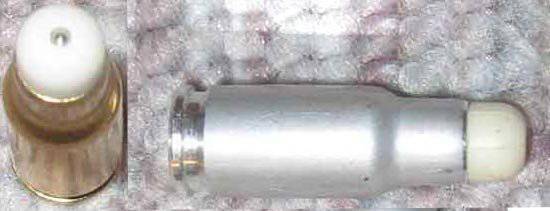
The basis of the Swedish patron 6,5х25 was an improved sleeve from the cartridge 7,62х25 (or Mauser, or Borchardt, it all depends on who "worships" which religion). In the process of adaptation for a new ammunition, the liner was pereobzhat under the new caliber, and also its bottom was strengthened so that it could withstand the higher pressure of powder gases. It is worth noting that I also liked this ammunition because of the use of the original cartridge, since I am of the opinion that 7,62х25 was written off very early and now, with its improvement, you can get a very good modern cartridge for the army, which was shown by the Swedes.
The most interesting, and most importantly, the easiest solution was a bullet caliber 6,5 millimeters. Its design is an armor-piercing core with a diameter of 4 millimeter, which is packed in a plastic sheath. Due to the use of plastic, the mass of the bullet is very small - a little more than 2 grams, but with a barrel length of 200 millimeters, the powder charge accelerates this bullet to 830 meters per second.
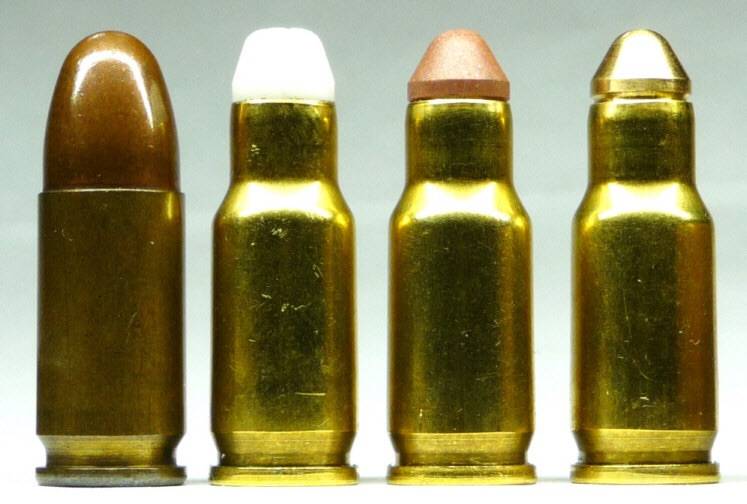
What is the strength of this ammunition? At a distance of 50 meters, its bullet pierces 7 millimeters of rolled armored plates, and at a distance of 230 meters it can hit a CRISAT target, that is, pierces a bulletproof vest consisting of a titanium plate of 1,6 millimeter thick and 20 layers of aramid fabric.
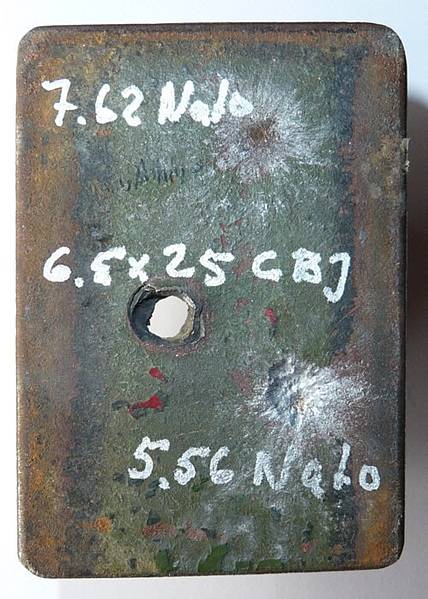
Particularly impressive are the photos, which give examples of bullets hit by a NATO patron in caliber 7,62 and 5,56 and a patron 6,5x25 CBJ in armor-piercing. By the way, these photos can give an incorrect idea of the superiority of this munition over 7,62x51 and 5,56x45, the fastest cartridges were used with lead core bullets, and the bullets were simply “smeared” on the armor upon hit.

It is worth noting that this cartridge was developed for a submachine gun, and not for a pistol, because some of its characteristics may seem unnecessarily exaggerated, and some of them are insufficient for cartridges for pistols. But the main thing here is not the cartridge itself, but the idea of using plastic around the armor-piercing core. Certainly such a decision will have a positive effect on the price of the ammunition and the ammunition production process. In addition, such a cartridge will be more benign to the bore, which will affect its durability. By the way, it is also noted that the barrel in the process of shooting remains more “clean”, apparently the combustion products are removed along with the subsequent plastic shot of the bullet.
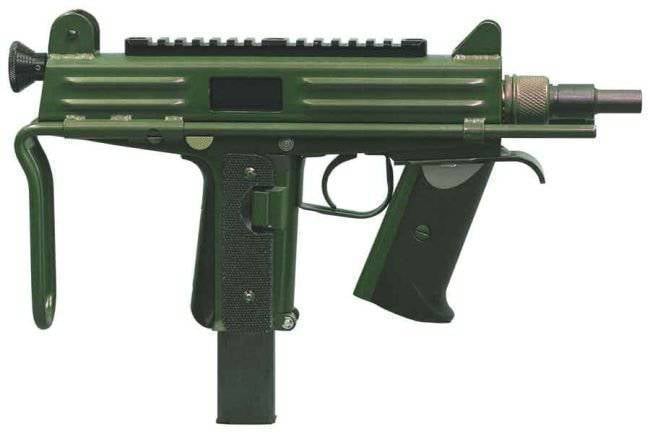
However, this munition has a number of drawbacks, without them, unfortunately, nowhere. Far from all polymers will behave in the same way when the temperature changes over a wide range, so it’s impossible to make a bullet by melting a couple of bottles found in the trash. It is necessary to take into account both the lowest possible temperatures and the highest temperatures that occur with intensive firing from the PP. That is, you need a polymer that does not become too brittle at low temperatures and will not be too ductile at high. Do not forget about the coefficient of expansion with temperature. On the other hand, with the modern development of the polymer industry, this problem can certainly be solved, once the Swedes succeeded, the climate of which is clearly not tropical in the country.

The armor-piercing bullet of this cartridge is not the only one, there are other options, even ammunition with a semi-bullet bullet, which shows very good indicators on the effectiveness of hitting, but, of course, no armor-piercing. Such a cartridge would be in demand in law enforcement, which brings us to the next paragraph of the article.
Cartridges for pistols and submachine guns for law enforcement
If for the army, with the proliferation of body armor, armor-piercing for short-barreled weapons came to the forefront, then for the law enforcement agencies, in the overwhelming majority, it is important to guarantee that you will not want to continue the resistance from the first shot. As I see it, cartridges with a semi-bullet bullet or bullets with an expansive cavity are not bad for this. The ideal option would be a bullet with a plastic “nose” covering the expansive cavity, which combines both maximum efficiency in contact with and acceptable ballistics. The truth is that there may be a problem for doctors to find plastic in the body of the person who hit such a bullet, but metal powder can always be added to plastic or this issue can be solved in some other way.
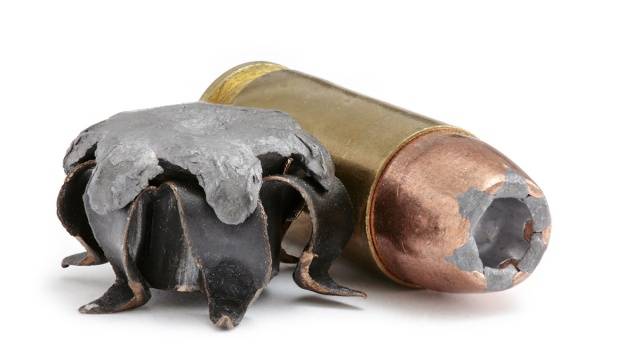
The ideal option for such bullets, I think not from excessive bloodthirsty, but for good reasons. First of all, such ammunition will force you to take the weapon more seriously, since it will be understood that when fired, with a very high probability, not a wounded, but a corpse is formed. In addition, it is not uncommon for law enforcement officers to encounter people under the influence of alcohol, interesting substances and just a body weight more than 120 a kilogram, for which the hit of 9x18 bullet is often a weak stopping argument. Do not forget about animals, in particular, many breeds of dogs, with appropriate training and stock character, do not perceive the hit cartridge 9x18 as something serious, at least, until the adrenaline level goes down.
From all this we can conclude that the use of cartridges with such bullets is more than justified. It should also be borne in mind that the need to use weapons by law enforcement officers often arises within the city and in the premises, that is, the distance of use is small, but there is a risk of rebounding from the walls of buildings.
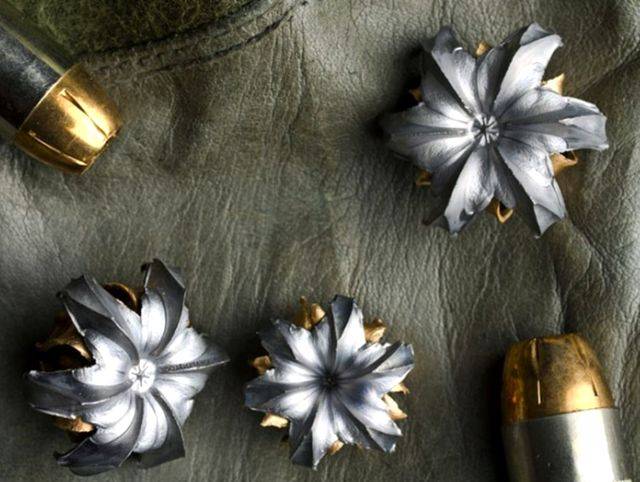
This means that the bullet must be heavy enough. When hit, it should remain in the body of the enemy, so as not to injure those who are standing behind, to have a reduced ability to ricochet when confronted with solid objects and to have a short distance for a direct shot so as not to fly out the window of someone's apartment when they miss. Pistols for law enforcement agencies are not sports weapons, and most employees, frankly, are very far from Sergey Nikolayevich Pyrzyanov, therefore it is reasonable not to create a “sniper” pistol, but weapons and ammunition capable of providing accurate firing at 20-25 meters. which, conversely, speaks in favor of heavy bullets.
It is impossible not to touch on the topic of the widespread distribution of AKSU in law enforcement. To whom the first thought came to give these weapons to law enforcement officers, one can only guess, but the use of these weapons by a police officer within the city limits may have the most negative consequences.
In my opinion, this weapon should be changed for a long time for submachine guns, in which, of course, the use of cartridges with the same type of bullets, which was discussed above, will be more than doubtful. For the PP, which could replace the AKSU, we need a cartridge that provides the smoothest possible trajectory of the bullet at a distance of up to 75-100 meters, but it is very desirable that these two cartridges be made on the same base.
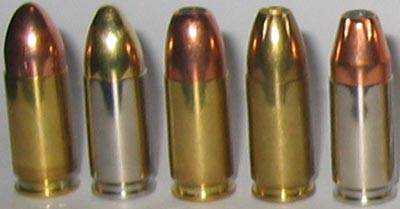
With a great desire to write that both versions of ammunition have long been implemented on the basis of .45АСР, I still turn to the remnants of common sense and tend to ammunition 9x19, among the variety of options for which there are options with bullets that meet the requirements and ammunition, as for pistols, and to the cartridges for a submachine gun.
This is applicable to all non-special police officers. For special units of law enforcement agencies, everything will depend on the situation, and a number of ammunition and weapons at their disposal are already quite extensive.
Once again, I clarify that my opinion does not claim to be the ultimate truth, this is only my vision of the issue on the cartridges for pistols and submachine guns for the army and the police. I do not even rule out that over time my opinion may change, which, in my opinion, is quite normal, strange, when over the years a person doesn’t change his opinion on the contrary. In this regard, I propose to discuss the issue of these ammunition and modern requirements in the army and the police for pistols and for submachine guns.

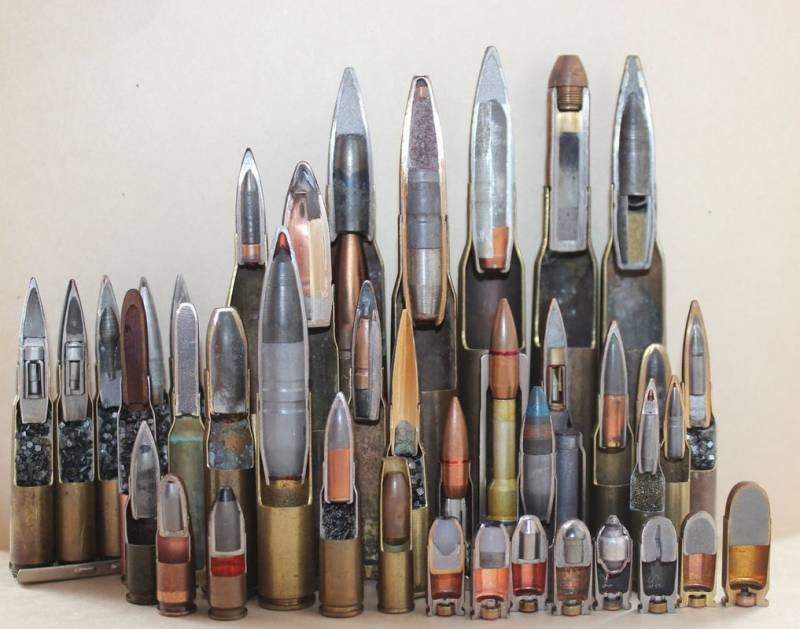
Information